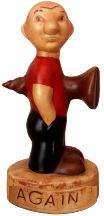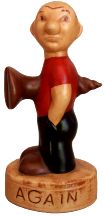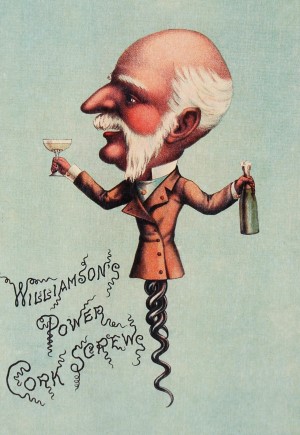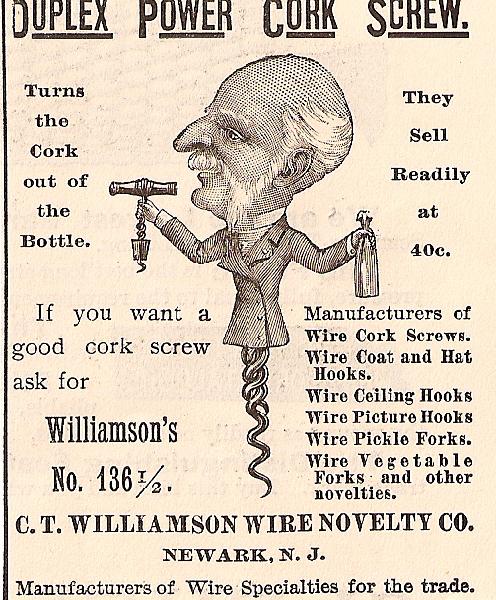 |
 The Virtual Corkscrew Museum's Weekly Newspaper |
 |
 |
 The Virtual Corkscrew Museum's Weekly Newspaper |
 |
|
Sunday, February 22, 2009 |
Number 544 |
The American Corkscrew Industry
.

Editor's Note: This article is from the October 10, 1891 issue of theThe Manufacturer and Builder.
Corkscrews are made by the million in the United States. Newark, N. J., is the principal seat of the industry of corkscrew making, one firm in that city is making and selling 150,000,000 in a single year. If the corkscrews, which average three inches in length, that were made during the year 1886, could have been laid end to end, they would have reached from New York to San Francisco, and then spanned the broad Pacific and touched the shores of Japan. That will give some idea of the number, says Iron Industry. But this is only one firm. Could all the corkscrews made last year be known, there must be enough manufactured to supply every man, woman and child on earth with one. To make the 150,000,000 of the Newark firm, required seventy-five men simply for twisting of the screws, to say nothing of making of wooden and other styles of handles. They worked the year round at it.
One would hardly think that more than three or four varieties are required, but there are about forty on the market. They include ring handle, steel wire screws for demijohns and large bottles, the double ring, handily encased pocket screw, the folding screw, and the broad wire handle screw. Some time ago an ice-pick and a cigar-box opener was made with a screw concealed in the steel tube handle. The tube can be slipped off, and the ice-pick forms the handle for the screw. Another novelty has a brush in the handle, so that the colored waiter may not be obliged to turn his fingers around the inside of the neck of the wine bottle to remove particles of cork and dust. For champagne bottles, a screw is made with a blade in one end of the handle to cut the wire around the cork. Another kind contains both the knife and the brush on the handle. The power corkscrew is an ingenious arrangement, which saves the knees and arms from a tussel with an obstinate and fractious cork. A cone of steel fits over the neck of the bottle, and the screw draws the cork while the cone presses the bottle.
In addition to his corkscrew patents, a New York man amused himself by twisting up wire in almost every conceivable shape, thereby supplying the five-cent counter with novelties and himself with a comfortable income in addition to that previously made by his ingenious faculties. The spiral thumb-screw which can be pushed into a board and easily removed after serving as a temporary hat-rack, is one of his inventions. It is only a piece of twisted wire, and can be purchased for $1 a gross. Spiral paper hooks, wall hooks, hat and coat racks, spiral picture nails, spiral copper tacks and stair buttons, card suspenders and holders, bill files, soap holders, pickle forks, toasting forks, and shoe button hooks are his inventions, and are manufactured in Newark.
The oddest corkscrew is the left- handed one. The first one was made for a left-handed barkeeper, and it suited so well that the Newark firm now keeps them constantly in stock. Another Newark firm made 300,000 pocket corkscrews a year. The question naturally arises what is done with them all? Lots of them are broken, of course, and all saloons keep dozens of them on hand. Large restaurants like Delmonico's, the Brunswick and the St. James, buy corkscrew direct from Newark, and get them by the hundreds at a time. It is no unusual thing for the big hardware houses in New York, Boston, Philadelphia, Pittsburgh, Chicago, Cincinnati, and the big Western cities to buy 10,000 corkscrews at a time. If the corkscrew is any sign of the prevalence of intemperance, and of the drinking habit in general, then prohibitionists have good cause to be disheartened. If one firm finds a market for 150,000,00 a year, how man bottles do they uncork? Certainly one corkscrew will open at least a dozen bottles before its usefulness is ended. If that be true, then the Newark firm referred to furnished material for the opening of 1,800,000 bottles.

To Draw a Corkscrew without a Corkscrew
On August 7, 1865, Geo. T. McLauthlin wrote to the editors of The Scientific American "To draw corks from bottles without injury to the cork and without the aid of any instrument, grasp the bottle in the hand and strike it squarely upon any firm place, right side up, with such force as it will bear without danger of breaking. A few blows will extract any ordinary cork, whether the bottle be full or only partially so."
Click on the photo to watch a video submitted by reader Joe Paradi.
|
©2009 Don Bull, Editor |